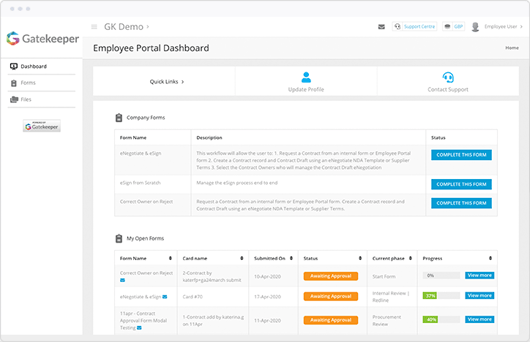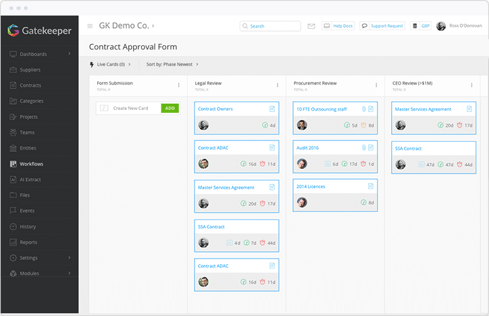It’s no secret that Legal and Contract Teams in many organisations are overburdened with administrative tasks. Depending on the size of an organisation, its rate of growth and its level of contract management maturity, administrative tasks include:
- Redlining contracts during periods of negotiation
- Extracting key information from existing and new agreements
- Storing and sharing contracts and relevant documentation
- Routing and tracking approvals with stakeholders and third-parties
Combine these activities with interruptions and requests from employees across the business and many companies are left with inefficient processes, a lack of control over the contract portfolio and a Legal or Contract Team that is prevented from achieving its strategic objectives.
To improve collaboration across your organisation and protect your Legal team and Contract teams’ time, employee requests need to be standardised and centralised. This article explores how this can be achieved through a dedicated Employee Portal.
Four advantages of using an Employee Portal
1. Centralised and standardised requests
Rather than making requests verbally or via email, an employee portal ensures requests are made in the same, proscribed format and stored in a single place. This prevents fragmentation, time being spent chasing requests or requests being missed altogether - saving your business from bottlenecks and hampering relationships with any third parties.
An online Employee Portal gives your teams a dedicated URL where they can go to submit requests. Further to this, Legal and Contract teams can standardise inbound submissions by configuring forms and mandating the information to be provided. Simple standardisation can be achieved by using fields such as:
- Form name and description
- Which department the submission is coming from
- What the purpose of the request is
- Who the counterparty or stakeholder is
Further refinement can be achieved through the use of dependent fields and dropdowns so that information submitted remains tightly controlled and accurate.
Not only does submission via a dedicated URL improve overall control, it also saves Legal and Contract teams time as they no longer need to execute repetitive tasks such as chasing incomplete information. Furthermore, other teams can also have confidence that their requests for new contracts and vendors will be responded to.
 Gatekeeper's Employee Dashboard
Gatekeeper's Employee Dashboard
2. Automatically build vendor and contract records
When the request process is sporadic, data capture is often inconsistent - especially if the request is being taken by teams that are already overburdened. Another benefit of using an Employee Portal and public forms for requests is that Legal and Contract teams can delegate the capture and extraction of contract metadata to other departments.
When other teams are responsible for providing metadata such as contract type, value and end date through forms, the administrative burden is immediately shared and data accuracy is greatly improved.
The power of contract and vendor management software also means that this form data, along with all versions of the documents, can be quickly digitised into a complete record that’s supported by an audit trail. This trail provides complete transparency, allowing teams to take back time that would otherwise have been spent manually searching for information or tracing updates that have been made.
3. Faster request processing through workflows
All requests made through an Employee Portal can be immediately funnelled into automated workflows. This improves the speed at which requests are processed as it ensures they are routed to the correct individual for approval. This leads to further benefits downstream such as faster time-to-signature and happier internal and external stakeholders.
As requests move automatically through a workflow engine, Legal and Contract can reduce their administrative work and spend more time focusing on strategic goals. Whether approvals need to go to multiple parties or have a complex sequence that needs to be followed, the entire organisation can have visibility and confidence in the fact that the process will be completed accurately and efficiently.
 The internal view: contracts in progress through the approval workflow
The internal view: contracts in progress through the approval workflow
4. Greater efficiency via self-serve
Not only does an Employee Portal provide a central hub for submissions, but it also gives individuals across the organisation the ability to log in and see the current status of each request and record.
This improves collaboration by reducing the amount of interruptions experienced by Legal and Contract teams as request updates are shared more readily across the business. It also gives individuals greater visibility of their requests, improving communication with any third-parties who can receive instant and accurate updates as a result.
Employees also don’t have to log in every time they want to receive an update about their requests. Notifications of changes are emailed to all parties inside and outside of the Employee Portal so all parties can stay informed about progress and approvals of contract and vendor requests.
Final Thoughts
An Employee Portal benefits the entire organisation by creating seamless collaboration between all teams involved in the process of contract and vendor requests and approvals.
Legal and Contract teams are able to minimise unexpected interruptions and random requests as well as dramatically reducing the time spent chasing other departments for key data.
By giving employees a dedicated portal to log in and review the status of their requests, responsibility and control is shared more evenly and accurately across the organisation and will result in better communication between teams and third parties.
To discover how your teams can benefit from an Employee Portal and other contract management tools, book your Gatekeeper demo or contact us.

.png)
.png)
.png)
-4.png)